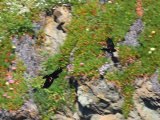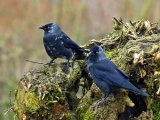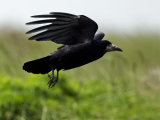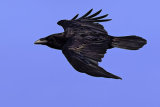Crows & Starlings
Crows & Allies
Medium to large birds; many species are black or black and grey; others are pied; others are more colourful or well-patterned. Eight species breed in the UK; there are many others around the world. Most crows are adaptable but often shy where persecuted; in towns, some become tame and may visit gardens. They all have strong, scaly feet, and stout (or downcurved) bills, mostly with a small patch of bristly feathers covering the nostrils. Northern populations of some species are migratory or nomadic, others are entirely .
For more information click here
Starlings
A family of small birds in Europe, Asia and Africa; many are strikingly coloured and iridescent. One species is regular in the UK, both as a resident and as a winter visitor. Starlings are almost thrush-sized, but more upright, on strong legs, with short tails, pointed wings and sharply-pointed bills. They are also more social, forming closer, often much larger, flocks and feeding quickly in busy, squabbling groups where food is abundant.
For more information click here
Text (c) RSPB, used with permission
Medium to large birds; many species are black or black and grey; others are pied; others are more colourful or well-patterned. Eight species breed in the UK; there are many others around the world. Most crows are adaptable but often shy where persecuted; in towns, some become tame and may visit gardens. They all have strong, scaly feet, and stout (or downcurved) bills, mostly with a small patch of bristly feathers covering the nostrils. Northern populations of some species are migratory or nomadic, others are entirely .
For more information click here
Starlings
A family of small birds in Europe, Asia and Africa; many are strikingly coloured and iridescent. One species is regular in the UK, both as a resident and as a winter visitor. Starlings are almost thrush-sized, but more upright, on strong legs, with short tails, pointed wings and sharply-pointed bills. They are also more social, forming closer, often much larger, flocks and feeding quickly in busy, squabbling groups where food is abundant.
For more information click here
Text (c) RSPB, used with permission









